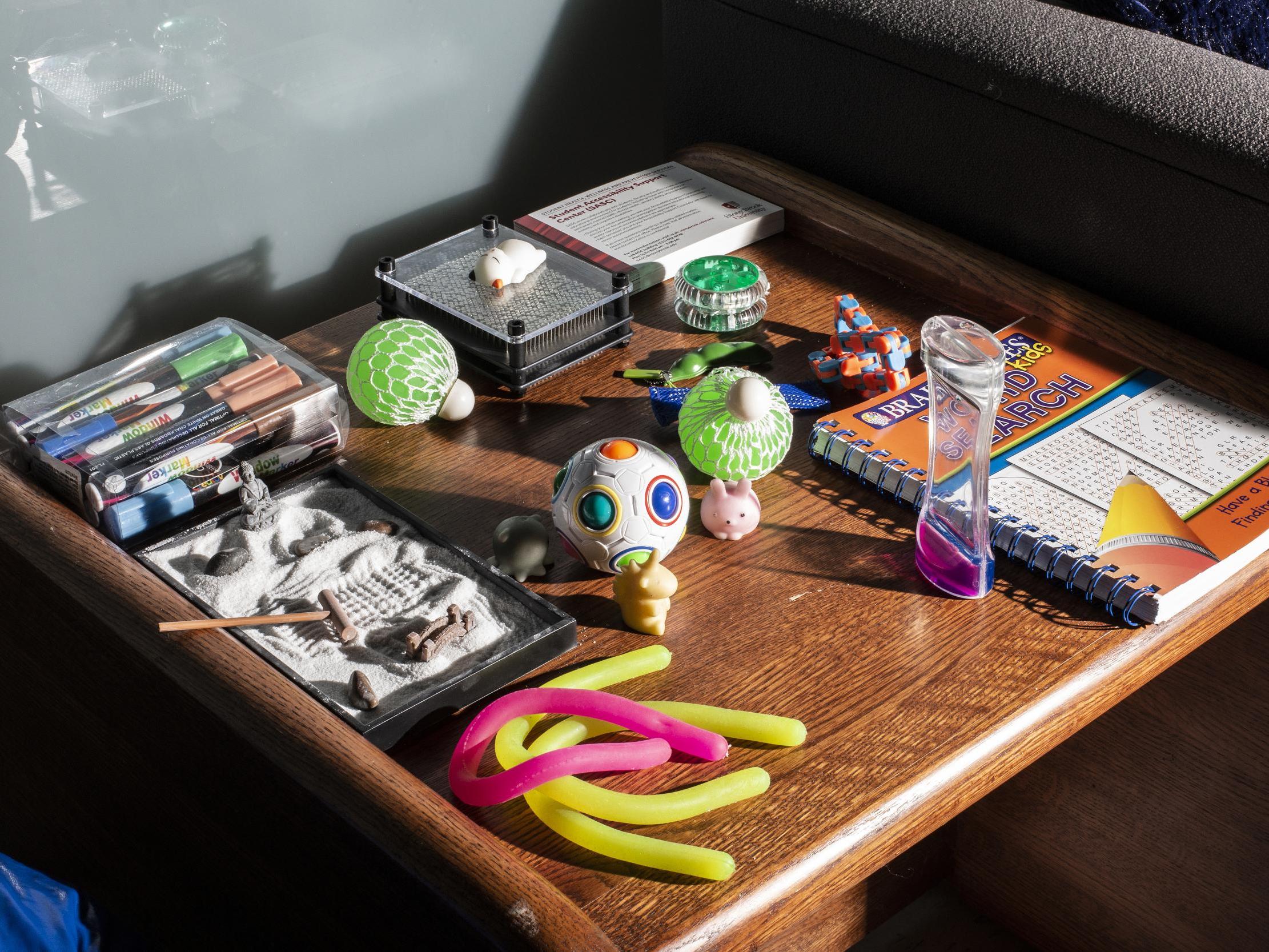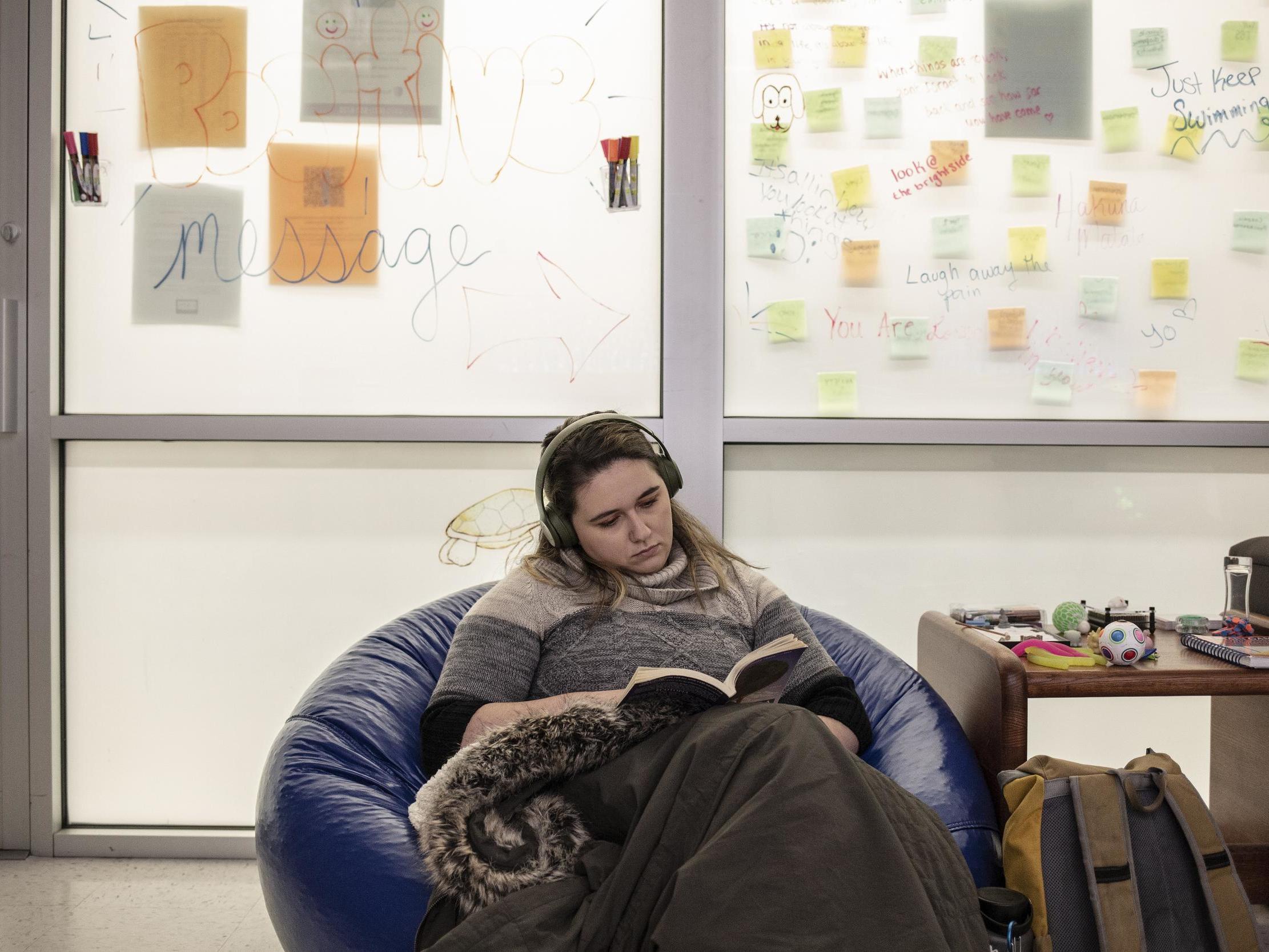US colleges offering sensory rooms to students with anxiety, autism and ADHD
Stony Brook, Minnesota and Adelphi universities lead way with disability friendly spaces

Emma Morse, a senior biology major, likes the room’s low chairs, where she can read and not be bothered. Her college’s library is too chaotic, she said, and she feels more comfortable sitting closer to the ground than most chairs allow.
Tracy Colena, a first-year student majoring in chemical engineering, comes to the same sensory room when he’s feeling stressed and overwhelmed by university life. The fidget toys are a good distraction and help him return to his day feeling calmer and more in control.
For Elyse Samojedny, a senior majoring in psychology, the room’s “bubble wall” remains its main attraction. Her attention-deficit/hyperactivity disorder makes it hard for her to focus. But sitting up close to the white noise and constant stream of video bubbles “blocks everything out, so I can focus on my breath,” she said.
College has resumed on America’s campuses, and most students can work through their start-of-semester stress with a trip to the gym, a comforting call with a parent or a late-night binge.
But for some students, normal days are a challenge – let alone high-stress exam periods and the beginning of a new term. That’s why a small but growing number of schools offer special rooms where students with anxiety, autism, ADHD, post-traumatic stress disorder or sensory challenges can go to decompress.
Adelphi University in New York appears to have started the trend. Since January 2018, the university has had a sensory room set aside for students who need downtime with or without stimulation. For some, the bubble lights and gentle white noise help bring calm; for others, peace comes with a heavy blanket and noise-cancelling headphones. Such sensory rooms aim to appeal to people with a range of needs, allowing them to choose for themselves what will help.
Ms Morse, Mr Colena and Ms Samojedny attend Stony Brook University, part of the State University of New York, on Long Island. Last summer, Wendi Mathews, who directs the school’s Student Accessibility Support Centre, turned a waiting room into a sensory room. About 30 per cent of the centres’ students used to sit in that space, killing time before taking a test or seeing a counsellor. This past fall, though, more than 75 per cent who visited the support centre reported using the sensory room while waiting; other students come specifically to sit in the room, taking advantage of the special pillows, seating and activities to regain their composure, feel better about themselves or simply catch a few minutes of peace.
There is a clear need for rooms such as this for students who are neurodiverse, said Mitchell Nagler, director of the Bridges to Adelphi Program, which includes the nearly two-year-old sensory room. “They are college material, but they need supports that are not typically available on a college campus,” Mr Nagler said.
Because of stigma and ignorance, many schools don’t know or don’t acknowledge that they have neurodiversity in their student body, Mr Nagler said. But “there are students on every college campus who are neurodiverse. Whether the college or university accepts that fact is up to them.”

These students are academically successful enough for college-level work, but their chance of success in higher education is limited if they don’t have the proper supports, Mr Nagler said.
Under federal law, every college and university has to offer basic support to students with disabilities: note-takers in class for those who can’t take their own and extended time on tests. And there must be accommodations for students with physical disabilities, such as elevators for those who can’t climb stairs.
Still, only about one-third of students with disabilities who enroll in a four-year college manage to graduate within eight years, according to federal data.
“Kids who are neurodiverse, we’re asking them to do things that they don’t do [naturally] on their own,” Mr Nagler said.
He’s quick to add that his students are held to the same academic standards as their peers. They have to turn work in on time, manage without an aide in class and get graded on the same scale as others.
“They’re expected to do the same work as all other Adelphi students,” Mr Nagler said.
At Adelphi, the Bridges program includes personalised academic, social and vocational services, as well as the sensory room, which is open from 8am to 8pm weekdays and 9am to 4pm Saturdays. The sensory room includes a bubble wall, a peg light wall where people can move coloured pegs around on a light board, weighted blankets, beanbag chairs and a half-egg-shaped swing that feels kind of like a womb, Mr Nagler said.
The program costs students an extra $9,000 (£7,000) a year on top of tuition. But Mr Nagler is certain he has helped kids earn college degrees who otherwise would not have made it through, or who would have struggled a lot more.
When he started the Bridges program in 2007, Mr Nagler had three students. Now there are 125 a year. “The program is a destination,” he said. “People come to Adelphi for a lot of reasons. . . . Most of the students who are in Bridges came to the university because of the Bridges program.”
At Stony Brook, someone suggested the idea of a sensory room to Ms Mathews in June. By July, she’d already begun outfitting the space.
The long, wide space has comfy couches, decorated with sensory pillows – some fuzzy, some with sequins that have a satisfying feel and sound when stroked. There are a few low chairs. Sometimes, people with sensory issues feel better closer to the ground, so they don’t get dizzy looking down.
Wall stickers have textures that some people enjoy running their fingers up and down. The wall of screens with endless bubbles remains the most striking feature. The wall opposite is plastered with notes, allowing students to contribute to the space themselves, adding positive messages: “Beautiful things happen when you distance yourself from negativity,” one reads.
Some students come in between classes to get a break or recharge.
The old room had desks and computers but wasn’t used much and “wasn’t warm and welcoming,” Ms Mathews said. Now students are spending more time in the room, “reading, doing homework. Legs are up. On their laptops. It was an easy transition when we thought about our students.”
Ms Mathews said people from other parts of the university have started to ask how they can add sensory components to their own spaces.
At the University of Minnesota at Duluth, two rooms in the school’s Kathryn A Martin Library have been converted into sensory-friendly rooms.
At Adelphi and Stony Brook, the rooms were funded with $10,000 (£8,000) grants from KultureCity, a Birmingham, Alabama, charity that has supported 500 sensory rooms nationwide, mainly at sporting events and concerts. Julian Maha, the emergency medicine physician who founded KultureCity to help his own son, who is on the autism spectrum, said he hopes to spread the rooms to more universities – both to help students with sensory issues and to raise awareness among neurotypical young people.
“That’s where change, and culture change in particular, can functionally begin,” Mr Maha said. “If they get it, it’s going to translate on a really, really big scale.”
At some point, Ms Mathews said, everyone is going to experience anxiety or depression. Showing students of all types ways to cope can help, she said. “Just being able to utilise coping skills in a safe environment is so important,” she said.
It doesn’t take a lot to make people with sensory issues feel more welcome, she said. A rocking chair in the corner. Tennis balls on the legs of chairs to keep them from squeaking, a large rubber band on chairs that students can use to let out some energy, bouncing while sitting in class.
Ms Samojedny said there’s more to a good sensory room than toys and distractions; it has to be a space designed with student needs in mind.
“Just throwing a beanbag in the corner isn’t going to do anything, but this is so well planned out,” said Ms Samojedny, who hopes to become an environmental lawyer.
Sensory rooms are most useful when college stress is at its highest, Mr Nagler said – during the first and last two weeks of the semester, when students are getting used to a new environment or under unrelenting pressure to finish final papers and study for exams.
“Anxiety is contagious,” he said. “The folks I work with are susceptible to catching [it],” and a sensory room, he said, provides “a good place to hide out when you’re overwhelmed.”
The Washington Post
Join our commenting forum
Join thought-provoking conversations, follow other Independent readers and see their replies
Comments